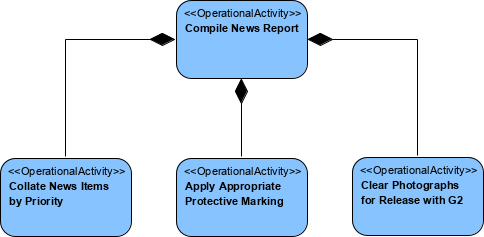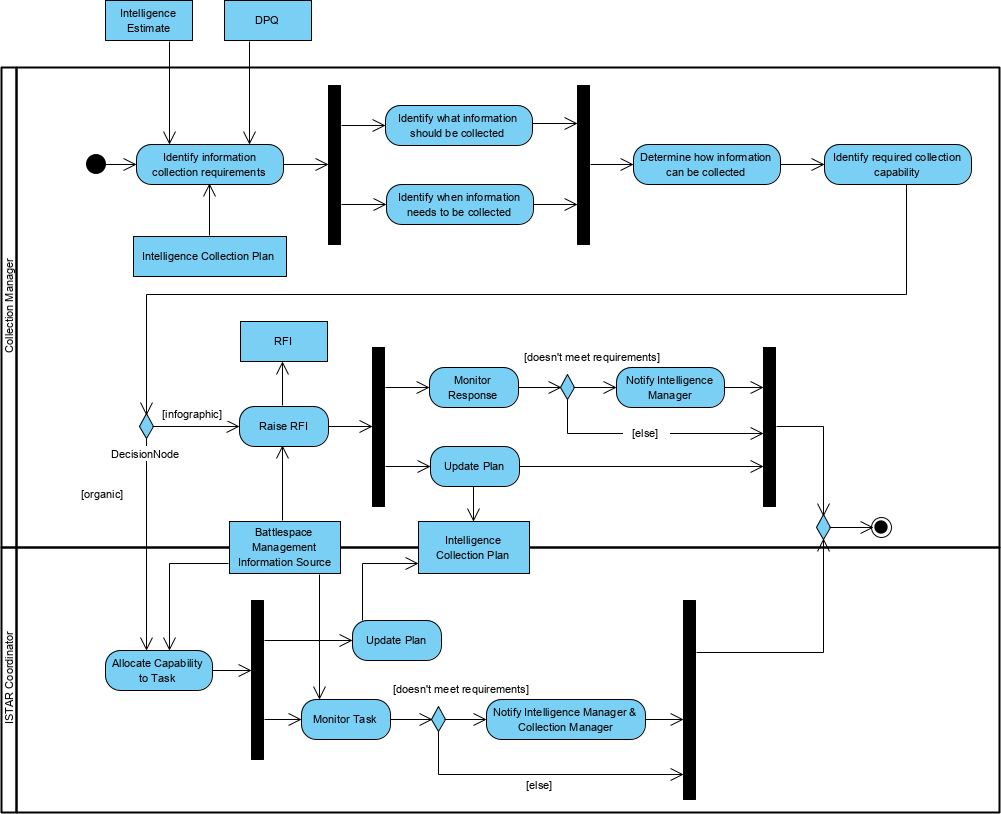The OV-5 describes the activities that are conducted in the course of achieving a mission or a business goal. It describes operational activities, the flows (inputs and outputs) between activities and may optionally show the nodes that conduct the activities.
OV-5 describes the operational activities (or business processes) that are being conducted within the mission or scenario.
OV-5 activity models describe the business processes associated with the architecture, as well as the:
- Relationships or dependencies among the business processes.
- Information exchanged between business processes.
- External interchanges (from/to business processes that are outside the scope of the model).
An operational activity is a logical process, specified independently of how it is carried out. To maintain this independence from implementation, logical nodes in OV-2, Operational Node Relationship Description, are used to represent the structure that carries out the operational activities. Operational activities are realised as functions in the SV-4, Functionality Description; i.e. the OV-5 describes that “what” which is mapped to the SV-4 that defines the “how”.
In the Operational Viewpoint, the OV-5 complements the OV-2. OV-2 focuses on the nodes, and the OV-5 focuses on the operational activities undertaken by those nodes. Consequently, the OV-2 and OV5 are usually developed together in an iterative fashion.
Usage
The intended usage of the OV-5 includes:
- Requirements capture (input to URD).
- Description of business processes and workflows.
- Operational planning.
- Logistic support analysis.
- Information flow analysis.
- Support task analysis to determine training needs.
Product Description
The OV-5 describes the activities that are normally conducted in the course of achieving a mission or a business goal. It describes operational activities (or business processes) and the input and output flows between those activities.
The activities described in an OV-5 may be standard operational activities which are defined in StV-6, Standard Operational Activities to Capability Mapping. Standard operational activities are those defined in doctrine, but which are not tailored to a specific requirement, i.e. they may be used across multiple logical architectures.
There are two diagrams to depict activity models, as explained below.
Operational Activity Decomposition Tree
The activity hierarchy shows activities depicted in a tree structure and is typically used to provide a navigation aid.
Operational Activity Model
The OV-5 activity flow diagram shows activities related by flows. Input / outputs of operational activities relate to information elements of OV-3, Operational Information Exchange Matrix, and are further characterised by the information exchange attributes described in OV-3. The information elements may be further described using OV-7, Information Model.
The operational activities in an OV-5 are undertaken by nodes from the corresponding OV-2. Consequently, the level of detail and decomposition in the OV-5 will be aligned with the complexity of the relationship of the nodes in the OV-2.
Operational activities may consume or produce information. When these cross node boundaries they are carried by information exchanges shown in the OV-2. In this way an OV-5 can contribute to IER analysis.
Annotations to the activities may also identify the costs (actual or estimated) associated with performing each activity.
The business rules that govern the performance of the activities can be keyed to each activity – the business rules may be described in OV-6a, Operational Rules Model.
In addition, a process flow model may be annotated with the names of the nodes responsible for conducting those activities, in swimlanes.
Creating an Operational Activity Decomposition Tree
To create an Operational Activity Decomposition Tree:
- Click on Operational Activity Decomposition Tree in the Action Artifact area, and then select Create New Diagram.
- Type the diagram name and press Enter.
- A blank diagram is created and you can start constructing the view. Create OperationalActivities through the tool under the diagram toolbar.
Optional actions:
Reuse OperationalPerformers (recommended) through dragging and dropping them from the Model Explorer, and traces the OperationalPerformers to the OperationalActivities using the IsCapableToPerform connector.
Creating an Operational Activity Model
To create an Operational Activity Model:
- Click on Operational Activity Model in the Action Artifact area, and then select Create New Diagram.
- Type the diagram name and press Enter.
- A blank diagram is created and you can start constructing the view. Create the activity flows with OperationalActivityActions and other flow elements (e.g. Control Flows, Decision Nodes, etc).
Operational Activity Decomposition Tree

Operational Activity Model

MODAF in Visual Paradigm
The MODAF is brought to you by Visual Paradigm, a full-featured development platform. Visual Paradigm provides an easy-to-use, model-driven MODAF tool that supports the development of MODAF views and models. You can create integrated MODAF products and generate architectural documents that facilitate organizations to efficiently coordinate enterprise architecture initiatives.